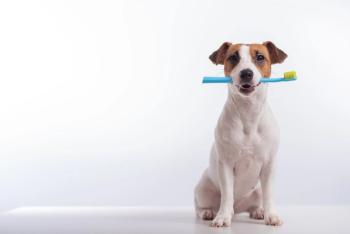
Restorative dental materials (Proceedings)
As veterinary technicians we will usually be assisting the doctor with restorative procedures.
Purpose of Restorative Dentistry
• Return the tooth to optimum form and function
• Prevent the breakdown of any remaining tooth structure
• Protect the pulp tissue from infiltration by bacteria and debris, which could lead to infection and in some cases pulpal necrosis
• Return the tooth to a more normal appearance
Common Uses for Dental Materials in General Practice
• Enamel only defects of the crown surface
• Grade 1 odontoclastic resorptive lesions – this does carry an 80% failure rate due to the progressive nature of the disease.
• Surface irregularities on the occlusal surface of molar teeth
Types and Function of Common Restorative Materials
Bonding Agent – used to attach restorative material to a tooth. It is applied to an etched enamel or dentin surface forming a strong micromechanical bond. A single step bonding agent is the easiest one to use.
Composite Resins – a tooth colored plastic silicon dioxide mixture. A compactable or condensable composite has a thick malleable consistency to restore large and deep defects in the tooth surface. A flowable composite is a more liquid material used in areas of low stress.
Dental Adhesive – an intermediate substance, usually a bonding agent, to allow two materials to stick together
Dental Etchant – a liquid or gel made of maleic or phosphoric acid. It is applied to the enamel or dentin surface to remove the smear layer. This allows the bonding agent to penetrate the dentinal tubules to allow the micromechanical bond between the tooth and the restoration.
Glass Ionomer Cement – a dental material with low strength and toughness which is generally used in small restorations in low stress areas such as in class 1 resorptive lesions or as an intermediate layer where there is pulp exposure and you need extra protection against leakage between the pulp and the restoration.
Dental Sealants or Pit and Fissure Sealants – this is usually applied to occlusal surfaces to cover any surface irregularities. These usually have a fluoride component to help prevent cavities. They can be applied to maxillary molars where early staining is noticed.
Curing or polymerization – this can occur either chemically when a base and catalyst are mixed, or by exposing the restorative material to a high intensity blue plasma or halogen light. Some restorative materials will be cured in 2 stages – chemically – when the materials are initially mixed followed by light curing.
Basic Steps of a Dental Restoration
Prepare the filling site – remove any unsupported enamel using a bur, dental chisel or a sharp curette. The margins of the site should be beveled to provide the most bonding surface area. This does not apply to the occlusal surfaces.
Clean the surface – polish the surface using flour pumice. Pumice does not contain any additives such as fluoride and glycerin which may not allow the restorative materials to work properly. Rinse and air dry the surface.
Acid etch the surface – this step removes any smear layer on the surface and allows the restoration material to enter into the dentinal tubules which allows the bonding mechanism to occur. Place gauze sponges around the tooth to protect the soft tissue. Apply enough etchant to fill the defect and the margin edges and allow it to sit on the surface per the manufacturer's instructions. Using a cotton swab, remove as much of the etchant material as possible. Place a gauze sponge behind the tooth and thoroughly rinse away any remaining etchant into the sponge. Dry the surface using oil free air. The surface should appear chalky.
Apply the bonding agent – place a drop of the bonding agent into a dappen dish. Apply the bonding agent using a microbrush in a thin layer. Blow a gentle stream of air over the bonding material to thin out the layer and avoid pooling. Using a light bonding gun, cure the bonding agent per the manufacturer's instructions.
Apply the restorative material – Flowable – squeeze a small amount of flowable composite material onto the surface. Use a brush to spread the material out evenly including the edges of the surface. Using a light bonding gun, cure the composite per the manufacturer's instructions.
Apply the restorative material – Compactable – remove a small amount of composite material using a working instrument and pack it into the defect. In general, compactable composite is placed in 2.0mm layers. Using a light bonding gun, cure each composite layer per the manufacturer's instructions.
Shaping the hardened composite – using sanding disks on a contra angle on a low speed handpiece or finishing burs, the restoration is smoothed to match the level of the normal enamel. This step requires training given by a dental specialist.
Conclusion
As veterinary technicians we will usually be assisting the doctor with restorative procedures. It is important for the technician to know which restoratives will be used for which procedures. In some cases, the technician will need to prepare the ingredients prior to placement. It is also important to know the steps of each restorative procedure so that materials can be laid out ahead of time in the proper order.
Newsletter
From exam room tips to practice management insights, get trusted veterinary news delivered straight to your inbox—subscribe to dvm360.



